In the Himalayas, sickness home to the Dalai Lama, this land has many monasteries either perched on cliffs or resting in quiet valleys. Most of them were built centuries ago. They have survived wars, invasions, harsh weather, and other forms of human apathy. And even after all these years, they stand magnificently against the backdrop of high snow capped mountains.
These monasteries are always abuzz with young Lamas. Sometimes you will find them deep in meditation and at others chanting in low voices. During festivals they like rejoicing in the name of god and happily dance to the tunes of pipes and horns.
So, if you too are intrigued by the mysteries and grandeur of the monasteries and want a dose of ancient scriptures, here’s a list of the 5 monasteries in the Indian Himalayas, you should not miss.
1. Hemis Monastery, Ladakh
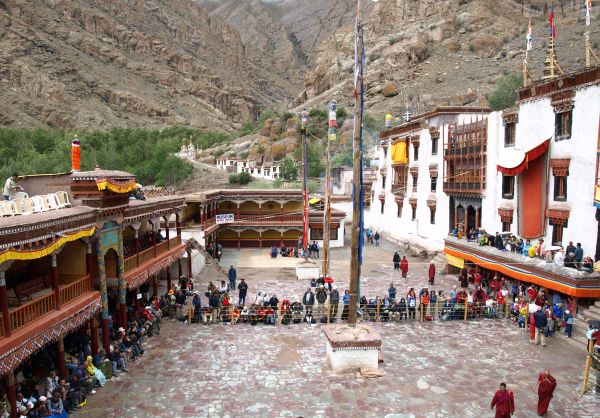
Nestling in the mountains of Ladhak, this spectacular monastery is a colorful treat to the eyes. Hordes of tourists are attracted to its ancient status. And, although many believe it isn’t the most beautiful monastery, it does hold your attention with its lively ambiance. For any first time visitor, you must know-this monastery is the oldest and the richest in the Ladakh region. It was first established in the 11th cs restored version from the 17th century.
As you enter through its gate, you are welcomed by a beautiful statue of Buddha made of copper. Its walls are draped with exotic thangkas and murals. These relics portray mystique stories from the past legends and put you through a series of imagination. Also, you’ll find the place dotted with gold and silver stupas; they bring its wealth to light.
Location – It is 45 kilometers southeast of Leh and lies off the Leh highway, in the village by the same name, Hemis.
Best time to visit– Visit the monastery during June/July when they organize the Hemis festival, which celebrates the existence of Lord Padmasambhava. Masked dancers perform fascinating dances in the monastery courts and pray for the lord to improve their spiritual condition.
Official wesite – http://www.drukpa-hemis.org/
2. Key(Ki) Monastery, Spiti
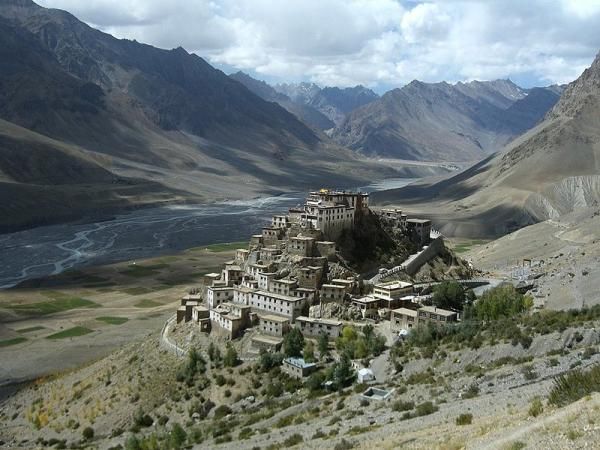
A few kilometers off the road from Kaza, when you spot a conical hill dominated by whitewashed buildings, you know you’ve reached the Key Gompa. The structure of interconnected buildings is so huge it looks more like a fortress or a township, but not really a monastery. This is because over the centuries the monastery has suffered attacks from the Mongols and other tribes, and the patch up jobs have left the place with haphazard structures.
More than 300 Lamas receive their religious training in the monastery every year. It has a rich store of scriptures and paintings of Buddha and a collection of ancient murals and books. Visitors often see the lamas practicing various forms of dance and singing, or performing other forms of art including playing music with pipes and horns.
Location– it is situated 12 kilometers from Kaza in the Spiti valley of Himachal Pradesh. It sits atop a 4116 meters high hillock.
Best time to visit– During June/July every year they hold the annual Ki Chaam festival, which witnesses flocks of tourist from around the world. Then again during March, they hold the Losar festival, where masked dancers give exhilarating performances.
3. Tabo Monastery, Spiti
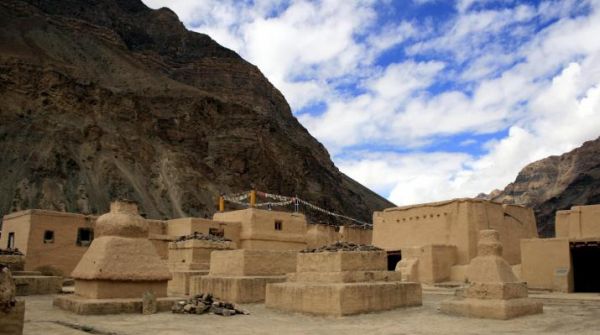
Tabo Monastery is among the oldest Buddhist learning centers in the Trans-Himalayan Region and considered by many as the second most important after the Tholing Gompa in Tibet. Surrounded by an arid and rocky desert, it sits in a quiet valley and consists of nine temples, spread across 6300 square meters. Among these temples, the most famous is the temple of the ‘Enlightened God.’ It holds the four fold figure of Vairocana and many murals dedicated to the ‘Wheel of Law.’
Referred to as the Ajanta of Himalayas, its walls are covered with murals and carved sculptures. Also there are many paintings and thangkhas, which depict the history of the region. They highlight Tabo as the meeting point of the Tibetan and Indian cultures. Visitors are allowed to stay with the monks and get a firsthand account about their lives and the Buddhist teachings.
Location– It is situated 47 km from Kaza in a small village Tabo, in the Spiti Valley of Himachal Pradesh.
Best time to visit– summer months starting from May up to October is the best time to visit Tabo. From October onward, it remains cut off as the Rohtang Pass closes due to snowfall.
Official website– http://tabomonastery.org/
4. Thiksey Monastery, Ladkah
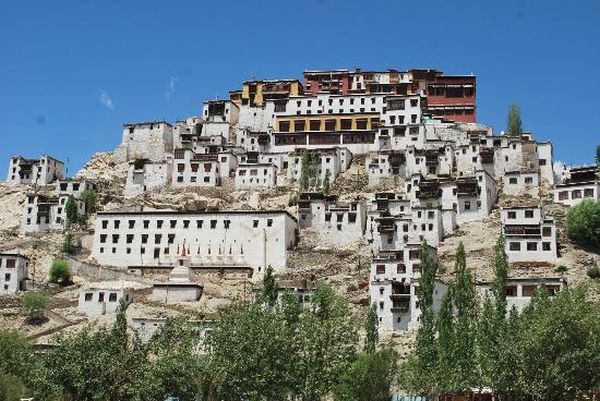
The largest monastery in central Ladakh, it is often referred to as ‘Mini Potala’ for its close resemblance to the Potala Palace in Lhasa. When approached from a distance, you can clearly make out the hierarchal structure rising up to the skies. It comprises of 10 temples encompassed within a 12 storey structure along with 120 residences for monks. It overlooks the Indus valley and visitors are taken aback by the breadth taking views around.
The most outstanding feature of this monastery is the 40 feet high statue of Maitreya or the future Buddha. You’ll immediately recognize it from the various travel promoting posters it is widely used on. Among other things, what draws many people to this monastery is its proximity from Leh. You can attend morning prayers, visit the various temples and get back by evening.
Location– It is situated 17 kilomters south of Leh in Jammu and Kashmir.
Best time to visit– the best time to visit it from the month of May up to October. After that the road to Leh are closed for the winter.
Official website– http://thikseymonastery.org/history2.html
5. Dhankar Monastery, Spiti
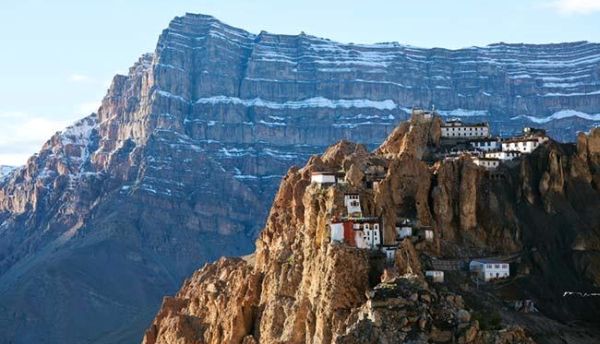
Located at the highest point in the Spiti Valley, the Dhankar Monastery sits on the cliff like a fortress and offers a panoramic view of the low lying areas and the Spiti River. Legend says that it was once upon a time home to the Nonos, the royals of the areas. They mostly used it as prison for their captives. Over the centuries, not much has changed and like other mountain regions, this far off Buddhist center remains cut off from modernization.
The most prominent feature of the monastery is the statue of the Vairocharan or the Dhayan Buddha, with four complete figures that sit back to back. Besides this, it holds ancient scripture, murals and its walls are decorated with beautiful thangkas. At a distance of 2.5 kilometers there lies the Dhankar Lake. It’s is ringed around by glacial mountain and peaks. The tough trek up to the lake dissuades most tourists to visit it, but for trekkers it is a delight to reach there.
Location– it is situated 25 km east of Kaza in Spiti, Himachal Pradesh.
Best time to visit– The best time to visit it is from May to October.
Choose your time, pack your bags, and move into the Himalayas because if you are looking for the peace of mind, you will definitely find it here.

Hiya, I am really glad I have found this information. Nowadays bloggers publish just about gossips and web and this is really annoying. A good blog with interesting content, that is what I need. Thanks for keeping this website, I’ll be visiting it. Do you do newsletters? Can not find it. dakadfedgaed
[…] Buddism in Bhutan. Yep – at Paro Taktsang…., not just for that reason, there are lots of monasteries in the Himalayas and of course, in case it needs more cred (it doesn’t), this guy lives […]
I want to join monastery what should i do…